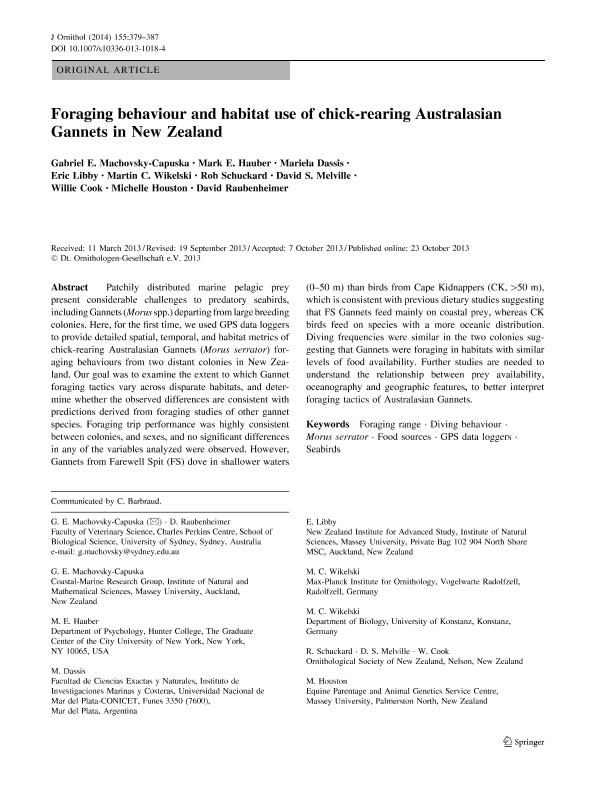Mostrar el registro sencillo del ítem
dc.contributor.author
Machovsky-capuska, Gabriel

dc.contributor.author
Hauber, Mark E.
dc.contributor.author
Dassis, Mariela

dc.contributor.author
Libby, Eric
dc.contributor.author
Wikelski, Martin C.
dc.contributor.author
Schuckard, Rob
dc.contributor.author
Melville, David S.
dc.contributor.author
Cook, Willie
dc.contributor.author
Houston, Michelle
dc.contributor.author
Raubenheimer, David
dc.date.available
2023-01-02T15:31:45Z
dc.date.issued
2014-01
dc.identifier.citation
Machovsky-capuska, Gabriel; Hauber, Mark E. ; Dassis, Mariela; Libby, Eric ; Wikelski, Martin C. ; et al.; Foraging behaviour and habitat use of chick-rearing Australasian Gannets in New Zealand; Springer Berlin Heidelberg; Journal Fur Ornithologie; 155; 2; 1-2014; 379-387
dc.identifier.issn
0021-8375
dc.identifier.uri
http://hdl.handle.net/11336/182897
dc.description.abstract
Patchily distributed marine pelagic prey present considerable challenges to predatory seabirds, including Gannets (Morus spp.) departing from large breeding colonies. Here, for the first time, we used GPS data loggers to provide detailed spatial, temporal, and habitat metrics of chick-rearing Australasian Gannets (Morus serrator) foraging behaviours from two distant colonies in New Zealand. Our goal was to examine the extent to which Gannet foraging tactics vary across disparate habitats, and determine whether the observed differences are consistent with predictions derived from foraging studies of other gannet species. Foraging trip performance was highly consistent between colonies, and sexes, and no significant differences in any of the variables analyzed were observed. However, Gannets from Farewell Spit (FS) dove in shallower waters (0-50 m) than birds from Cape Kidnappers (CK, >50 m), which is consistent with previous dietary studies suggesting that FS Gannets feed mainly on coastal prey, whereas CK birds feed on species with a more oceanic distribution. Diving frequencies were similar in the two colonies suggesting that Gannets were foraging in habitats with similar levels of food availability. Further studies are needed to understand the relationship between prey availability, oceanography and geographic features, to better interpret foraging tactics of Australasian Gannets. © 2013 Dt. Ornithologen-Gesellschaft e.V.
dc.format
application/pdf
dc.language.iso
eng
dc.publisher
Springer Berlin Heidelberg
dc.rights
info:eu-repo/semantics/openAccess
dc.rights.uri
https://creativecommons.org/licenses/by-nc-sa/2.5/ar/
dc.subject
FORAGING RANGE
dc.subject
DIVING BEHAVIOUR
dc.subject
MORUS SERRATOR
dc.subject
FOOD SOURCES
dc.subject
GPS DATA LOGGERS
dc.subject
SEABIRDS
dc.subject.classification
Zoología, Ornitología, Entomología, Etología

dc.subject.classification
Ciencias Biológicas

dc.subject.classification
CIENCIAS NATURALES Y EXACTAS

dc.title
Foraging behaviour and habitat use of chick-rearing Australasian Gannets in New Zealand
dc.type
info:eu-repo/semantics/article
dc.type
info:ar-repo/semantics/artículo
dc.type
info:eu-repo/semantics/publishedVersion
dc.date.updated
2022-12-27T18:13:31Z
dc.identifier.eissn
1439-0361
dc.journal.volume
155
dc.journal.number
2
dc.journal.pagination
379-387
dc.journal.pais
Alemania

dc.journal.ciudad
Berlin
dc.description.fil
Fil: Machovsky-capuska, Gabriel. Massey University; Nueva Zelanda. University of Technology Sydney; Australia
dc.description.fil
Fil: Hauber, Mark E.. City University of New York. The City College of New York; Estados Unidos
dc.description.fil
Fil: Dassis, Mariela. Consejo Nacional de Investigaciones Científicas y Técnicas. Centro Científico Tecnológico Conicet - Mar del Plata. Instituto de Investigaciones Marinas y Costeras. Universidad Nacional de Mar del Plata. Facultad de Ciencias Exactas y Naturales. Instituto de Investigaciones Marinas y Costeras; Argentina
dc.description.fil
Fil: Libby, Eric. Massey University; Nueva Zelanda
dc.description.fil
Fil: Wikelski, Martin C.. University Of Konstanz (university Of Konstanz); . Max-Planck Institute for Ornithology; Alemania
dc.description.fil
Fil: Schuckard, Rob. Ornithological Society of New Zealand; Nueva Zelanda
dc.description.fil
Fil: Melville, David S.. Ornithological Society of New Zealand; Nueva Zelanda
dc.description.fil
Fil: Cook, Willie. Ornithological Society of New Zealand; Nueva Zelanda
dc.description.fil
Fil: Houston, Michelle. Massey University; Nueva Zelanda
dc.description.fil
Fil: Raubenheimer, David. University of Technology Sydney; Australia
dc.journal.title
Journal Fur Ornithologie

dc.relation.alternativeid
info:eu-repo/semantics/altIdentifier/url/http://link.springer.com/article/10.1007/s10336-013-1018-4
dc.relation.alternativeid
info:eu-repo/semantics/altIdentifier/doi/http://dx.doi.org/10.1007/s10336-013-1018-4
Archivos asociados
